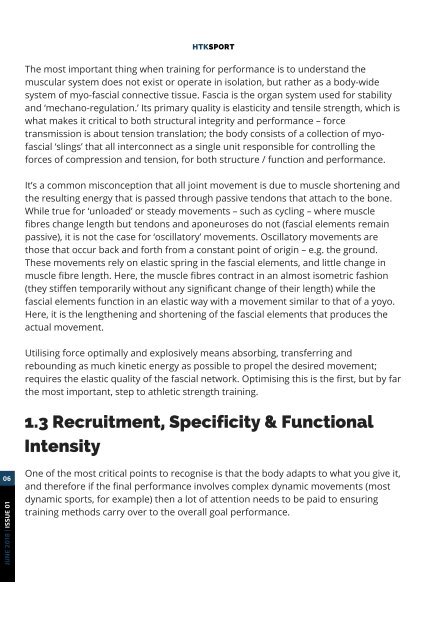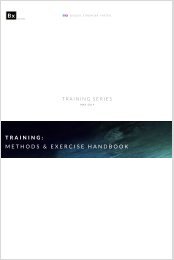Create successful ePaper yourself
Turn your PDF publications into a flip-book with our unique Google optimized e-Paper software.
HTKSPORT<br />
The most important thing when training for performance is to understand the<br />
muscular system does not exist or operate in isolation, but rather as a body-wide<br />
system of myo-fascial connective tissue. Fascia is the organ system used for stability<br />
and ‘mechano-regulation.’ Its primary quality is elasticity and tensile strength, which is<br />
what makes it critical to both structural integrity and performance – force<br />
transmission is about tension translation; the body consists of a collection of myofascial<br />
‘slings’ that all interconnect as a single unit responsible for controlling the<br />
forces of compression and tension, for both structure / function and performance.<br />
It’s a common misconception that all joint movement is due to muscle shortening and<br />
the resulting energy that is passed through passive tendons that attach to the bone.<br />
While true for ‘unloaded’ or steady movements – such as cycling – where muscle<br />
fibres change length but tendons and aponeuroses do not (fascial elements remain<br />
passive), it is not the case for ‘oscillatory’ movements. Oscillatory movements are<br />
those that occur back and forth from a constant point of origin – e.g. the ground.<br />
These movements rely on elastic spring in the fascial elements, and little change in<br />
muscle fibre length. Here, the muscle fibres contract in an almost isometric fashion<br />
(they stiffen temporarily without any significant change of their length) while the<br />
fascial elements function in an elastic way with a movement similar to that of a yoyo.<br />
Here, it is the lengthening and shortening of the fascial elements that produces the<br />
actual movement.<br />
Utilising force optimally and explosively means absorbing, transferring and<br />
rebounding as much kinetic energy as possible to propel the desired movement;<br />
requires the elastic quality of the fascial network. Optimising this is the first, but by far<br />
the most important, step to athletic strength training.<br />
1.3 Recruitment, Specificity & Functional<br />
Intensity<br />
06<br />
JUNE 2018 | ISSUE 01<br />
One of the most critical points to recognise is that the body adapts to what you give it,<br />
and therefore if the final performance involves complex dynamic movements (most<br />
dynamic sports, for example) then a lot of attention needs to be paid to ensuring<br />
training methods carry over to the overall goal performance.




